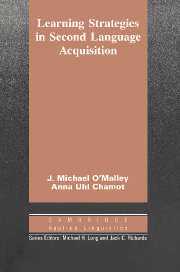Book contents
- Frontmatter
- Contents
- Series editors' preface
- Preface
- 1 Introduction
- 2 A cognitive theory of learning
- 3 How cognitive theory applies to second language acquisition
- 4 Learning strategies: methods and research
- 5 Strategies used by second language learners
- 6 Instruction in learning strategies
- 7 Learning strategies: models and materials
- 8 Summary and conclusions
- Glossary
- References
- Author index
- Subject index
7 - Learning strategies: models and materials
Published online by Cambridge University Press: 05 October 2012
- Frontmatter
- Contents
- Series editors' preface
- Preface
- 1 Introduction
- 2 A cognitive theory of learning
- 3 How cognitive theory applies to second language acquisition
- 4 Learning strategies: methods and research
- 5 Strategies used by second language learners
- 6 Instruction in learning strategies
- 7 Learning strategies: models and materials
- 8 Summary and conclusions
- Glossary
- References
- Author index
- Subject index
Summary
Research on the learning strategies that second language students generate and strategies that can be taught is of great significance in understanding the operation of cognitive processes during second language acquisition. Nevertheless, as educators, we are also interested in extending the information gained from research to the improvement of both learning and teaching second languages. To this end, instructional models and materials are helpful in illustrating the ways in which research findings can be converted into practical classroom activities.
This chapter first examines a recent instructional model utilizing learning strategy instruction in first language contexts. Then we discuss the model we designed to teach learning strategies in English as a second language instruction as well as a sample of second language instructional materials that incorporate learning strategies. Finally, we suggest some needed areas of research on applications of learning strategies to second and foreign language classrooms.
Instructional models in first language contexts: strategic teaching
Jones et al. (1987) have developed a framework for instruction in all content areas based on cognitive learning theory and its applications to instruction in mainstream native English-language classroom settings. The Strategic Teaching Model is based on the following six researchbased assumptions about learning (Jones et al. 1987):
Learning is goal oriented. Expert learners have two major goals during the learning process: to understand the meaning of the task and to regulate their own learning. In other words, learners have both declarative knowledge, or content goals, and procedural knowledge, or strategic goals for a learning task.
- Type
- Chapter
- Information
- Learning Strategies in Second Language Acquisition , pp. 187 - 213Publisher: Cambridge University PressPrint publication year: 1990



